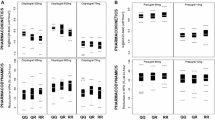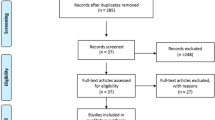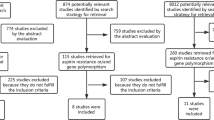Abstract
This meta-analysis was performed to assess the relationships between the PON1 Q192R (rs662 T>C) polymorphism and the clinical outcome of antiplatelet treatment after percutaneous coronary intervention (PCI). A range of electronic databases were searched: Web of Science (1945–2013), the Cochrane Library Database (Issue 12, 2013), PubMed (1966–2013), EMBASE (1980–2013), CINAHL (1982–2013) and the Chinese Biomedical Database (CBM) (1982–2013) without language restrictions. Meta-analysis was conducted using the STATA 12.0 software. The crude odds ratio (OR) with their 95 % confidence interval (CI) were calculated. Six clinical cohort studies with a total number of 5,189 patients undergoing PCI for coronary heart disease were included. Our meta-analysis revealed that the PON1 Q192R polymorphism was correlated with an increased risk of major adverse cardiovascular events (MACE) in patients receiving antiplatelet treatment after PCI (C allele vs. T allele: OR = 1.22, 95 % CI 1.04–1.43, P = 0.014; CT+CC vs. TT: OR = 1.38, 95 % CI 1.03–1.86, P = 0.029; CC vs. TT: OR = 1.45, 95 % CI 1.05–1.99, P = 0.024; respectively), especially among Asians. Furthermore, we found significantly positive correlations between the PON1 Q192R polymorphism and the incidence of stent thrombosis in patients receiving antiplatelet treatment after PCI (C allele vs. T allele: OR = 1.42, 95 % CI 1.08–1.87, P = 0.011; CT+CC vs. TT: OR = 1.93, 95 % CI 1.01–3.67, P = 0.046; CC vs. TT: OR = 2.18, 95 % CI 1.09–4.35, P = 0.027; respectively). Our meta-analysis of clinical cohort studies provides evidence that the PON1 Q192R polymorphism may increase the risk of MACE and stent thrombosis in patients receiving antiplatelet treatment after PCI.






Similar content being viewed by others
References
Caggegi A, Capodanno D, Capranzano P, Chisari A, Ministeri M, Mangiameli A, Ronsivalle G, Ricca G et al (2011) Comparison of one-year outcomes of percutaneous coronary intervention versus coronary artery bypass grafting in patients with unprotected left main coronary artery disease and acute coronary syndromes (from the customize registry). Am J Cardiol 108:355–359. doi:10.1016/j.amjcard.2011.03.050
Mause SF, Ritzel E, Liehn EA, Hristov M, Bidzhekov K, Muller-Newen G, Soehnlein O, Weber C (2010) Platelet microparticles enhance the vasoregenerative potential of angiogenic early outgrowth cells after vascular injury. Circulation 122:495–506. doi:10.1161/CIRCULATIONAHA.109.909473
Lhermusier T, Van Rothem J, Garcia C, Gratacap MP, Payrastre B (2011) Targeted drug therapy: the platelet side. Platelets 22:479–484. doi:10.3109/09537104.2011.567423
Chhatriwalla AK, Bhatt DL (2008) Should dual antiplatelet therapy after drug-eluting stents be continued for more than one-year? Dual antiplatelet therapy after drug-eluting stents should be continued for more than one-year and preferably indefinitely. Circ Cardiovasc Interv 1:217–225. doi:10.1161/CIRCINTERVENTIONS.108.811380
Tousoulis D, Paroutoglou IP, Papageorgiou N, Charakida M, Stefanadis C (2010) Recent therapeutic approaches to platelet activation in coronary artery disease. Pharmacol Ther 127:108–120. doi:10.1016/j.pharmthera.2010.05.001
Park KW, Park JJ, Kang J, Jeon KH, Kang SH, Han JK, Lee SE, Yang HM et al (2013) Paraoxonase 1 gene polymorphism does not affect clopidogrel response variability but is associated with clinical outcome after PCI. PLoS One 8:e52779. doi:10.1371/journal.pone.0052779
Trenk D, Hochholzer W, Fromm MF, Zolk O, Valina CM, Stratz C, Neumann FJ (2011) Paraoxonase-1 Q192R polymorphism and antiplatelet effects of clopidogrel in patients undergoing elective coronary stent placement. Circ Cardiovasc Genet 4:429–436. doi:10.1161/CIRCGENETICS.111.960112
Li WF, Costa LG, Richter RJ, Hagen T, Shih DM, Tward A, Lusis AJ, Furlong CE (2000) Catalytic efficiency determines the in vivo efficacy of pon1 for detoxifying organophosphorus compounds. Pharmacogenetics 10:767–779
Hulot JS, Collet JP, Cayla G, Silvain J, Allanic F, Bellemain-Appaix A, Scott SA, Montalescot G (2011) CYP2C19 but not PON1 genetic variants influence clopidogrel pharmacokinetics, pharmacodynamics, and clinical efficacy in post-myocardial infarction patients. Circ Cardiovasc Interv 4:422–428. doi:10.1161/CIRCINTERVENTIONS.111.963025
Wang X, Fan Z, Huang J, Su S, Yu Q, Zhao J, Hui R, Yao Z et al (2003) Extensive association analysis between polymorphisms of PON gene cluster with coronary heart disease in Chinese Han population. Arterioscler Thromb Vasc Biol 23:328–334. doi:10.1161/01.ATV.0000051702.38086.C1
Bouman HJ, Schomig E, van Werkum JW, Velder J, Hackeng CM, Hirschhauser C, Waldmann C, Schmalz HG et al (2011) Paraoxonase-1 is a major determinant of clopidogrel efficacy. Nat Med 17:110–116. doi:10.1038/nm.2281
Lewis JP, Fisch AS, Ryan K, O’Connell JR, Gibson Q, Mitchell BD, Shen H, Tanner K et al (2011) Paraoxonase 1 (PON1) gene variants are not associated with clopidogrel response. Clin Pharmacol Ther 90:568–574. doi:10.1038/clpt.2011.194
Plosker GL, Lyseng-Williamson KA (2007) Clopidogrel: a review of its use in the prevention of thrombosis. Drugs 67:613–646
Pereillo JM, Maftouh M, Andrieu A, Uzabiaga MF, Fedeli O, Savi P, Pascal M, Herbert JM et al (2002) Structure and stereochemistry of the active metabolite of clopidogrel. Drug Metab Dispos 30:1288–1295. doi:10.1124/dmd.30.11.1288
Camps J, Joven J, Mackness B, Mackness M, Tawfik D, Draganov D, Costa LG, Paragh G et al (2011) Paraoxonase-1 and clopidogrel efficacy. Nat Med 17:1041–1042. doi:10.1038/nm.2386
Price MJ, Murray SS, Angiolillo DJ, Lillie E, Smith EN, Tisch RL, Schork NJ, Teirstein PS et al (2012) Influence of genetic polymorphisms on the effect of high- and standard-dose clopidogrel after percutaneous coronary intervention: the gift (genotype information and functional testing) study. J Am Coll Cardiol 59:1928–1937. doi:10.1016/j.jacc.2011.11.068
Chen DY, Wang CY, Wen MS, Lee TH, Chu Y, Hsieh MJ, Chang SH, Lee CH et al (2012) Paraoxonase-1 is not a major determinant of stent thrombosis in a taiwanese population. PLoS One 7:e39178. doi:10.1371/journal.pone.0039178
Stang A (2010) Critical evaluation of the Newcastle–Ottawa Scale for the assessment of the quality of nonrandomized studies in meta-analyses. Eur J Epidemiol 25:603–605. doi:10.1007/s10654-010-9491-z
Zintzaras E, Ioannidis JP (2005) Hegesma: genome search meta-analysis and heterogeneity testing. Bioinformatics 21:3672–3673. doi:10.1093/bioinformatics/bti536
Peters JL, Sutton AJ, Jones DR, Abrams KR, Rushton L (2006) Comparison of two methods to detect publication bias in meta-analysis. JAMA 295:676–680. doi:10.1001/jama.295.6.676
Campo G, Ferraresi P, Marchesini J, Bernardi F, Valgimigli M (2011) Relationship between paraoxonase q192r gene polymorphism and on-clopidogrel platelet reactivity over time in patients treated with percutaneous coronary intervention. J Thromb Haemost 9:2106–2108. doi:10.1111/j.1538-7836.2011.04457.x
Sibbing D, Koch W, Massberg S, Byrne RA, Mehilli J, Schulz S, Mayer K, Bernlochner I et al (2011) No association of paraoxonase-1 Q192R genotypes with platelet response to clopidogrel and risk of stent thrombosis after coronary stenting. Eur Heart J 32:1605–1613. doi:10.1093/eurheartj/ehr155
Tang XF, Wang J, Zhang JH, Meng XM, Xu B, Qiao SB, Wu YJ, Chen J et al (2013) Effect of the CYP2C19 2 and 3 genotypes, abcb1 C3435T and pon1 Q192R alleles on the pharmacodynamics and adverse clinical events of clopidogrel in Chinese people after percutaneous coronary intervention. Eur J Clin Pharmacol 69:1103–1112. doi:10.1007/s00228-012-1446-8
Verschuren JJ, Boden H, Wessels JA, van der Hoeven BL, Trompet S, Heijmans BT, Putter H, Guchelaar HJ et al (2013) Value of platelet pharmacogenetics in common clinical practice of patients with st-segment elevation myocardial infarction. Int J Cardiol 167:2882–2888. doi:10.1016/j.ijcard.2012.07.020
Getz GS, Reardon CA (2004) Paraoxonase, a cardioprotective enzyme: continuing issues. Curr Opin Lipidol 15:261–267
Costa LG, Cole TB, Vitalone A, Furlong CE (2005) Measurement of paraoxonase (PON1) status as a potential biomarker of susceptibility to organophosphate toxicity. Clin Chim Acta 352:37–47. doi:10.1016/j.cccn.2004.09.019
Simon T, Steg PG, Becquemont L, Verstuyft C, Kotti S, Schiele F, Ferrari E, Drouet E et al (2011) Effect of paraoxonase-1 polymorphism on clinical outcomes in patients treated with clopidogrel after an acute myocardial infarction. Clin Pharmacol Ther 90:561–567. doi:10.1038/clpt.2011.193
Steinhubl SR, Berger PB, Mann JT III, Fry ET, DeLago A, Wilmer C, Topol EJ (2002) Early and sustained dual oral antiplatelet therapy following percutaneous coronary intervention: a randomized controlled trial. JAMA 288:2411–2420. doi:10.1001/jama.288.19.2411
Acknowledgments
We would like to acknowledge the reviewers for their helpful comments on this paper. This work was supported by Natural Science Foundation of China (NSFC) (grant #81202598), Shanghai Municipal Public Health Bureau (grant #2009068).
Conflict of interest
The authors declare no conflict of interest.
Author information
Authors and Affiliations
Corresponding author
Additional information
The Publisher and Editor retract this article in accordance with the recommendations of the Committee on Publication Ethics (COPE). After a thorough investigation we have strong reason to believe that the peer review process was compromised.
About this article
Cite this article
Li, P., Bu, SH., Lu, XT. et al. RETRACTED ARTICLE: Relationships between PON1 Q192R polymorphism and clinical outcome of antiplatelet treatment after percutaneous coronary intervention: a meta-analysis. Mol Biol Rep 41, 6263–6273 (2014). https://doi.org/10.1007/s11033-014-3509-7
Received:
Accepted:
Published:
Issue Date:
DOI: https://doi.org/10.1007/s11033-014-3509-7




